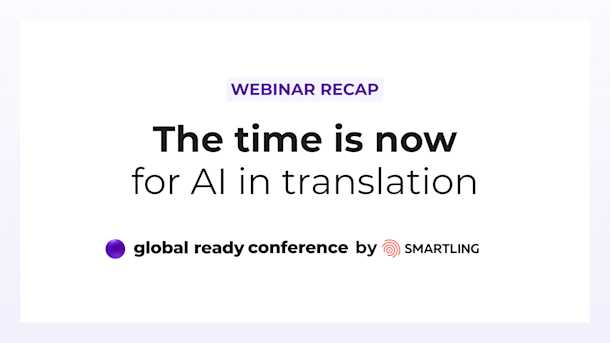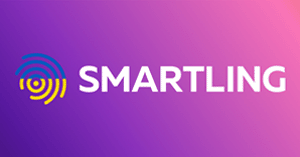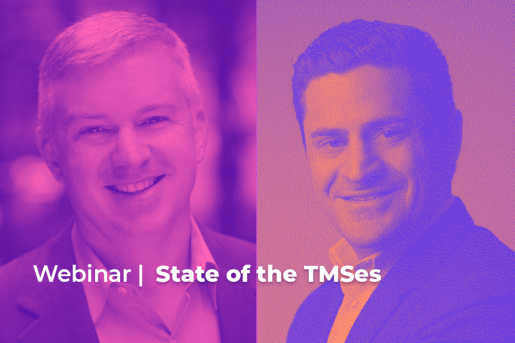Business and localization professionals have been hearing about the potential of AI to transform the localization industry for the last few years. And while there’s been a lot of excitement around what this will mean, there’s also been a lot of confusion. How exactly can we best leverage this technology? How will it impact our day-to-day work? And what jobs will (or won’t) exist?
At Smartling’s Global Ready Conference this year, we heard from localization leaders at SAS, FedEx, and Volvo about how they are prioritizing AI initiatives. We also spoke with Adam Wooten, associate professor of translation and localization management at the Middlebury Institute of International Studies at Monterey, about how he’s preparing his students to thrive during this period of rapid, industry-wide change. Read on for a few key takeaways from those conversations.
1. Embracing AI is not a choice but a necessity.
For Patricia Sainz, a translation program manager at SAS, AI has been a game-changer. In 2018, her team started down the AI path by experimenting with neural machine translation (NMT). Eventually, they added NMT to their translation mix for all the languages they support. Most recently, her team has been experimenting with Google’s AutoML, which allows them to create custom translation models unique to their business and content. They’ve also added glossary customization for several of their languages. So far, the results have been promising.
The effects of using AI-powered workflows have been far-reaching, too: “[AI] has been bringing a lot of speed to the table,” Sainz says. “It also is cost-efficient. It has enabled companies like us to translate more than we thought possible with the same resources.” That ultimately means SAS can provide a better user experience — which, in turn, creates more business opportunities.
Many other Smartling customers have similar stories to share: Smartling’s AI-powered tools have been their secret weapon, helping them achieve better translations for less money and in less time. But it’s also clear that as AI evolves, it will become less of a competitive advantage for translating companies and more a requirement for survival. Indeed, Sainz argues that “the time [for AI] is not now. It was yesterday.”
2. Get started by focusing on a specific use case.
The sheer amount of information about AI, mixed with hefty doses of optimism, doomsaying, and clickbait, is overwhelming. It can be hard to choose an avenue to explore — and to set realistic expectations for yourself and other key stakeholders about what AI can do.
So start small.
That is key, according to Nancy Ferreira da Rocha, senior localization program manager at FedEx. When asked for tips for evaluating AI tools and options, this was her recommendation: Look at your business goals and what you want to achieve. Then, start with something manageable, reduce the scope, try it out, and iterate from there.
FedEx’s AI journey, for example, is still in its infancy. The localization team dipped their toes into the AI-powered waters with NMT at the tail end of 2022 and into 2023. They first tried out-of-the-box NMT with post-editing and internal review. In recent months, after extensive testing, they have started to train MT engines with their translation memories and glossaries. They are now testing out different content types and ramping up their use of NMT — always with a human in the loop but also looking at areas where raw NMT output might be a good solution.
3. Managing expectations is crucial.
There are several potential pitfalls to AI translation, particularly if AI-powered translation tools are not implemented with care. Both Patricia Sainz (from SAS) and Nancy Ferreira da Rocha (from FedEx) emphasized the importance of heeding the adage, “Garbage in, garbage out.”
If there are issues with the source or the engines are not well-trained, it will affect your output. You will not get great results, and you may run into inconsistencies, biases, inclusivity issues, hallucinations, and more — all of which can negatively impact your brand. To mitigate the risk that something will go awry, your team, and your translation partners, should have a thorough understanding of both the benefits and pitfalls of using AI in translation.
Just as importantly, you’ll want to set realistic expectations with upper management and the executive team. Position yourself as an expert within your organization: share with others in your company what you learn about what can and cannot be achieved by adopting AI. That can help secure buy-in from key stakeholders and ensure all involved are aligned, making it easier to mitigate risk when implementing AI translation tools.
4. Machines are taking over, but in wonderful ways.
Top of mind for everyone — both for newcomers and for those already working in localization — is: Will I have a job in the coming years?
The answer is indisputably yes, according to Professor Adam Wooten of the Middlebury Institute of International Studies at Monterey. Machines may be taking over. But they’re doing so in wonderful ways. AI translation tools can make quick work of some of the more traditional (and tedious) tasks that take up much of the current day-to-day in a localization professional’s life.
But there are still human strengths that machines can’t match, such as big-picture thinking. Translators can potentially act as linguists who affect communication strategy more holistically. Translation managers may move into more strategic and bigger-picture roles, ones that do not just oversee content translation but also content creation. The possibilities are endless.
5. There will still be room for the responsible human
AI translation has enormous potential. But as Marcus Ivarsson, head of localization management at Volvo, points out, with it comes a lot of responsibility.
For example, in the coming years, he sees the connection between source and target becoming looser and looser. The source might consist of a brief, prompting the engine to generate content in the target language regarding a specific topic for a specific audience in a given market. In addition, the approval process might shift from approving each piece of content to approving this specific engine or way of generating content.
That puts a lot of pressure on what he calls the engine operators. In other words, Ivarsson says, there will still be room for the responsible human — even in an AI-powered world.
—
Want to hear more about implementing AI in translation? Watch this year’s Global Ready Conference in its entirety. All sessions are available on demand here.






